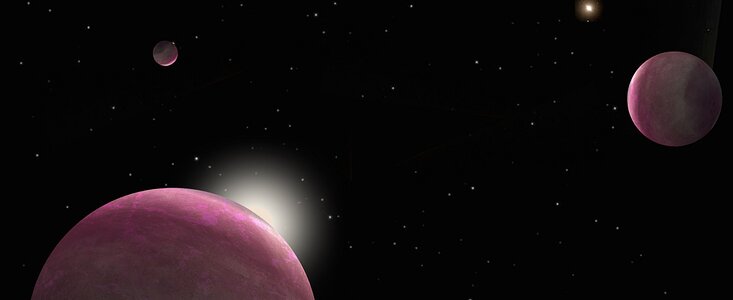Can Exoplanets Form in a Binary Star System?
31 May 2018
A new study using Gemini data reveals that the ratio of binary stars in Kepler’s K2 exoplanet host stars is similar to that found elsewhere in our neighborhood of the Milky Way. According to lead author Dr. Rachel Matson of NASA’s Ames Research Center, “While we have known that about 50% of all stars are binary, to confirm a similar ratio in exoplanet host stars helps set some important constraints on the formation of potential exoplanets seen by Kepler.”
Until recently, astronomers generally focused on single exoplanet host stars, believing that planets form primarily around lone stars like our Sun. However, the research led by Matson, who’s team observed 206 star systems, demonstrates that the influence of a neighboring star does not appear to deter planet formation. The presence of a very close neighboring star produces enormous collateral effects on a planetary system, possibly ejecting planets into interstellar space, or gravitationally interfering with their formation and orbits.
"In our sample we did not find evidence that the proximity of a companion star suppresses the formation of exoplanets, even at distances as small as 50 Astronomical Units, which is similar to the distance between the Sun and the edge of the Kuiper belt," explained Matson.
Dr. Steve Howell, Space Science & Astrobiology Division Chief at NASA Ames Research Center, a co-author of the study and leader of the Gemini Observatory high-resolution imaging effort, said, "We now have found that about half of the stars that host exoplanets are binary, both in the Kepler sample and now in the K2 sample, telling us we cannot ignore such systems and need to take them into account in our exoplanet studies."
The researchers used observations from the Gemini North and South telescopes, and the WIYN telescope using the Differential Speckle Survey Instrument (DSSI), for the high-resolution imaging of the K2 stars. The paper is accepted for publication in The Astrophysical Journal.
Abstract
It is well established that roughly half of all nearby solar-type stars have at least one companion. Stellar companions can have significant implications for the detection and characterization of exoplanets, including triggering false positives and masking the true radii of planets. Determining the fraction of exoplanet host stars that are also binaries allows us to better determine planetary characteristics as well as establish the relationship between binarity and planet formation. Using high angular resolution speckle imaging, we detect stellar companions within 1 arcsec of K2 planet candidate host stars. Comparing our detected companion rate to TRILEGAL star count simulations and known detection limits of speckle imaging we estimate the binary fraction of K2 planet host stars to be 40 - 50%, similar to that of Kepler exoplanet hosts and field stars.
Links
- A preprint of the paper can be found here.


